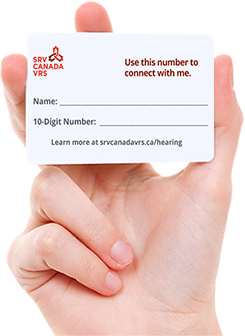Hearing Community
What is Canada VRS?
Canada VRS is a telecommunication service that allows Deaf, hard of hearing or speech-impaired Canadians to make telephone calls using internet and cell phone-based technologies. VRS callers are connected with a sign language interpreter who provides real-time interpretation for phone calls with hearing callers.
We strive to eliminate communication barriers amongst hearing and Deaf communities through the Canada VRS app by providing accessible video relay services that connect Canadians every day.
How a Canada VRS Call Works

Making a Call as a Hearing
(non-Deaf) Person
Step 1
Dial the Deaf caller’s 10-digit Canada VRS phone number.
Step 2
Once connected to a Video Interpreter, they will explain their role, then connect your call to the Deaf caller.
Step 3
The Video Interpreter will translate your message into ASL/ LSQ sign language, and the Deaf caller’s message into English/French.
Answering a Call as a Hearing
(non-Deaf) Person
Step 1
Your phone will ring.
Step 2
When you answer the phone, the Video Interpreter will inform you that a caller using sign language is trying to reach you.
Step 3
The Video Interpreter will explain their role, then connect you to the Deaf caller.
Step 4
The Video Interpreter will translate your message into ASL/LSQ sign language, and the Deaf caller’s message into English/French.
Using Canada VRS is Easy for Hearing People
- Hearing callers don’t require any additional software or the Canada VRS app.
- Hearing callers can dial, and answer calls just like any other phone call.
- No video is required for hearing callers.
- VRS calls are free
- VRS is available 24/7
FAQs From Hearing People
Canada VRS is available to those who use ASL or LSQ sign languages and those who speak English or French. Video Interpreters interpret ASL to English or LSQ to French and vice versa.
ASL and LSQ are sign languages. ASL stands for ‘American Sign Language’ and is primarily used by English Deaf or hard of hearing Canadians. LSQ stands for ‘Langue des signes québécoise’ and is used primarily by French Deaf or hard of hearing Canadians.
ASL originated in the American School for the Deaf in Hartford, Connecticut, USA in the early 19th century. Since then, ASL use has expanded in the US and Canada primarily via schools for the Deaf and Deaf community organizations.
LSQ was first developed in Quebec in 1850 as a mixture of French Sign Language (LSF) and American Sign Language (ASL). LSQ is used primarily in Quebec but also in francophone communities across Canada.
ASL and LSQ have their own unique rules of grammar and syntax and as is the case with most spoken languages, individual countries have their own sign languages and dialects that evolve over time.
As a hearing person, you do not need any special technology, equipment, or the Canada VRS app. Hearing callers can dial, and answer calls just like any other phone call.
There is no cost to use Canada VRS.
Canada VRS calls are available 24 hours a day, 7 days a week, and 365 days a year.
No. Hearing people don’t need to do anything different. Hearing callers can dial, and answer calls just like any other phone call.
The Video Interpreter (VI) is a specifically trained interpreter who connects Deaf, hard of hearing, Deaf-Blind or speech impaired Canadians with hearing people via Canada VRS. The VI interprets the VRS call and translates between spoken (English or French) and American Sign Language (ASL) and Langue des signes québécoise (LSQ).
Learn More: https://srvcanadavrs.ca/en/video-interpreters/the-vrs-call/
Every VI receives VRS training and follows CAV’s policies and guidelines. VIs adhere to strict confidentiality and privacy requirements. Confidentiality is important to our customers, and Canada VRS VIs do not and cannot record the content of calls.
If you receive a VRS call, remember, "Don't Hang Up!"
When you receive a VRS call the first thing you’ll hear is a VI letting you know that a caller who uses sign language is calling you. Remember, “Don’t Hang Up”. Sometimes there is a short delay while the VI connects you with your caller so please stay on the line.
This is what it sounds like when you receive a call from someone using Canada VRS.

